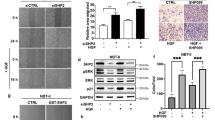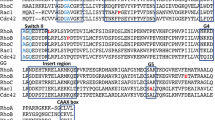Abstract
The non-receptor tyrosine kinase Src is a major player in multiple physiological responses including growth, survival and differentiation. Overexpression and/or oncogenic mutation in the Src gene have been documented in human tumors. The v-Src protein is an oncogenic mutant of Src, which promotes cell survival, migration, invasion and division. GRIM-19 is an antioncogene isolated using a genome-wide knockdown screen. Genes associated with Retinoid-IFN-induced Mortality (GRIM)-19 binds to transcription factor STAT3 and ablates its pro-oncogenic effects while v-Src activates STAT3 to promote its oncogenic effects. However, we found that GRIM-19 inhibits the pro-oncogenic effects of v-Src independently of STAT3. Here, we report the identification of functionally inactivating GRIM-19 mutations in a set of head and neck cancer patients. While wild-type GRIM-19 strongly ablated v-Src-induced cell migration, cytoskeletal remodeling and tumor metastasis, the tumor-derived mutants (L71P, L91P and A95T) did not. These mutants were also incapable of inhibiting the drug resistance of v-Src-transformed cells. v-Src downregulated the expression of Pag1, a lipid raft-associated inhibitor of Src, which was restored by wild-type GRIM-19. The tumor-derived mutant GRIM-19 proteins failed to upregulate Pag1. These studies show a novel mechanism that deregulates Src activity in cancer cells.
This is a preview of subscription content, access via your institution
Access options
Subscribe to this journal
Receive 50 print issues and online access
$259.00 per year
only $5.18 per issue
Buy this article
- Purchase on Springer Link
- Instant access to full article PDF
Prices may be subject to local taxes which are calculated during checkout






Similar content being viewed by others
References
Frame MC . Newest findings on the oldest oncogene; how activated src does it. J Cell Sci 2004; 117: 989–998.
Superti-Furga G, Fumagalli S, Koegl M, Courtneidge SA, Draetta G . Csk inhibition of c-Src activity requires both the SH2 and SH3 domains of Src. EMBO J 1993; 12: 2625–2634.
Hofmann ER, Boyanapalli M, Lindner DJ, Weihua X, Hassel BA, Jagus R et al. Thioredoxin reductase mediates cell death effects of the combination of beta interferon and retinoic acid. Mol Cell Biol 1998; 18: 6493–6504.
Angell JE, Lindner DJ, Shapiro PS, Hofmann ER, Kalvakolanu DV . Identification of GRIM-19, a novel cell death-regulatory gene induced by the interferon-beta and retinoic acid combination, using a genetic approach. J Biol Chem 2000; 275: 33416–33426.
Zhang J, Yang J, Roy SK, Tininini S, Hu J, Bromberg JF et al. The cell death regulator GRIM-19 is an inhibitor of signal transducer and activator of transcription 3. Proc Natl Acad Sci USA 2003; 100: 9342–9347.
Lufei C, Ma J, Huang G, Zhang T, Novotny-Diermayr V, Ong CT et al. GRIM-19, a death-regulatory gene product, suppresses Stat3 activity via functional interaction. EMBO J 2003; 22: 1325–1335.
Stark GR, Darnell JE Jr . The JAK-STAT pathway at twenty. Immunity 2012; 36: 503–514.
Yu CL, Meyer DJ, Campbell GS, Larner AC, Carter-Su C, Schwartz J et al. Enhanced DNA-binding activity of a Stat3-related protein in cells transformed by the Src oncoprotein. Science 1995; 269: 81–83.
Bromberg JF, Horvath CM, Besser D, Lathem WW, Darnell JE Jr . Stat3 activation is required for cellular transformation by v-src. Mol Cell Biol 1998; 18: 2553–2558.
Yu H, Pardoll D, Jove R . STATs in cancer inflammation and immunity: a leading role for STAT3. Nat Rev Cancer 2009; 9: 798–809.
Kalakonda S, Nallar SC, Gong P, Lindner DJ, Goldblum SE, Reddy SP et al. Tumor suppressive protein gene associated with retinoid-interferon-induced mortality (GRIM)-19 inhibits src-induced oncogenic transformation at multiple levels. Am J Pathol 2007; 171: 1352–1368.
Sun P, Nallar SC, Kalakonda S, Lindner DJ, Martin SS, Kalvakolanu DV . GRIM-19 inhibits v-Src-induced cell motility by interfering with cytoskeletal restructuring. Oncogene 2009; 28: 1339–1347.
Mazurek S . Pyruvate kinase type M2: a key regulator of the metabolic budget system in tumor cells. Int J Biochem Cell Biol 2011; 43: 969–980.
Oneyama C, Hikita T, Enya K, Dobenecker MW, Saito K, Nada S et al. The lipid raft-anchored adaptor protein Cbp controls the oncogenic potential of c-Src. Mol Cell 2008; 30: 426–436.
Byers LA, Sen B, Saigal B, Diao L, Wang J, Nanjundan M et al. Reciprocal regulation of c-Src and STAT3 in non-small cell lung cancer. Clin Cancer Res 2009; 15: 6852–6861.
Zhang XH, Wang Q, Gerald W, Hudis CA, Norton L, Smid M et al. Latent bone metastasis in breast cancer tied to Src-dependent survival signals. Cancer Cell 2009; 16: 67–78.
Sabe H, Hata A, Okada M, Nakagawa H, Hanafusa H . Analysis of the binding of the Src homology 2 domain of Csk to tyrosine-phosphorylated proteins in the suppression and mitotic activation of c-Src. Proc Natl Acad Sci USA 1994; 91: 3984–3988.
Nada S, Yagi T, Takeda H, Tokunaga T, Nakagawa H, Ikawa Y et al. Constitutive activation of Src family kinases in mouse embryos that lack Csk. Cell 1993; 73: 1125–1135.
Alchanati I, Nallar SC, Sun P, Gao L, Hu J, Stein A et al. A proteomic analysis reveals the loss of expression of the cell death regulatory gene GRIM-19 in human renal cell carcinomas. Oncogene 2006; 25: 7138–7147.
Liu YB, Shen WG, Ge H, Gai XD, Lu LL, Zhao XJ . [Expressions of survivin and GRIM-19 in prostate cancer]. Zhonghua nan ke xue 2011; 17: 21–26.
Zhou Y, Li M, Wei Y, Feng D, Peng C, Weng H et al. Down-regulation of GRIM-19 expression is associated with hyperactivation of STAT3-induced gene expression and tumor growth in human cervical cancers. J Interferon Cytokine Res 2009; 29: 695–703.
Zhou AM, Zhao JJ, Ye J, Xiao WH, Kalvakolanu DV, Liu RY . Expression and clinical significance of GRIM-19 in non-small cell lung cancer. Ai Zheng 2009; 28: 431–435.
Gong LB, Luo XL, Liu SY, Tao DD, Gong JP, Hu JB . Correlations of GRIM-19 and its target gene product STAT3 to malignancy of human colorectal carcinoma. Ai Zheng 2007; 26: 683–687.
Zhang Y, Hao H, Zhao S, Liu Q, Yuan Q, Ni S et al. Downregulation of GRIM-19 promotes growth and migration of human glioma cells. Cancer Sci 2011; 102: 1991–1999.
Hynes RO . Integrins: bidirectional, allosteric signaling machines. Cell 2002; 110: 673–687.
Murphy DA, Courtneidge SA . The 'ins' and 'outs' of podosomes and invadopodia: characteristics, formation and function. Nat Rev Mol Cell Biol 2011; 12: 413–426.
Weed SA, Parsons JT . Cortactin: coupling membrane dynamics to cortical actin assembly. Oncogene 2001; 20: 6418–6434.
Buday L, Downward J . Roles of cortactin in tumor pathogenesis. Biochim Biophys Acta 2007; 1775: 263–273.
Li X, Zheng H, Hara T, Takahashi H, Masuda S, Wang Z et al. Aberrant expression of cortactin and fascin are effective markers for pathogenesis, invasion, metastasis and prognosis of gastric carcinomas. Int J Oncol 2008; 33: 69–79.
Patel AS, Schechter GL, Wasilenko WJ, Somers KD . Overexpression of EMS1/cortactin in NIH3T3 fibroblasts causes increased cell motility and invasion in vitro. Oncogene 1998; 16: 3227–3232.
Li Y, Tondravi M, Liu J, Smith E, Haudenschild CC, Kaczmarek M et al. Cortactin potentiates bone metastasis of breast cancer cells. Cancer Res 2001; 61: 6906–6911.
Yamada S, Yanamoto S, Kawasaki G, Mizuno A, Nemoto TK . Overexpression of cortactin increases invasion potential in oral squamous cell carcinoma. Pathol Oncol Res 2010; 16: 523–531.
Theocharis S, Klijanienko J, Giaginis C, Alexandrou P, Patsouris E, Sastre-Garau X . FAK and Src expression in mobile tongue squamous cell carcinoma: associations with clinicopathological parameters and patients survival. J Cancer Res Clin Oncol 2012; 138: 1369–1377.
van Oijen MG, Rijksen G, ten Broek FW, Slootweg PJ . Overexpression of c-Src in areas of hyperproliferation in head and neck cancer, premalignant lesions and benign mucosal disorders. J Oral Pathol Med 1998; 27: 147–152.
Chen JY, Hung CC, Huang KL, Chen YT, Liu SY, Chiang WF et al. Src family kinases mediate betel quid-induced oral cancer cell motility and could be a biomarker for early invasion in oral squamous cell carcinoma. Neoplasia 2008; 10: 1393–1401.
Koppikar P, Choi SH, Egloff AM, Cai Q, Suzuki S, Freilino M et al. Combined inhibition of c-Src and epidermal growth factor receptor abrogates growth and invasion of head and neck squamous cell carcinoma. Clin Cancer Res 2008; 14: 4284–4291.
Matsouka PT, Flier JS . Relationship between c-src tyrosine kinase activity and the control of glucose transporter gene expression. Mol Endocrinol 1989; 3: 1845–1851.
White MK, Rall TB, Weber MJ . Differential regulation of glucose transporter isoforms by the src oncogene in chicken embryo fibroblasts. Mol Cell Biol 1991; 11: 4448–4454.
Valle Casuso JC, Gonzalez-Sanchez A, Medina JM, Tabernero A . HIF-1 and c-Src mediate increased glucose uptake induced by endothelin-1 and connexin43 in astrocytes. PLoS One 2012; 7: e32448.
Koppenol WH, Bounds PL, Dang CV . Otto Warburg's contributions to current concepts of cancer metabolism. Nat Rev Cancer 2011; 11: 325–337.
Jiang LQ, Feng X, Zhou W, Knyazev PG, Ullrich A, Chen Z . Csk-binding protein (Cbp) negatively regulates epidermal growth factor-induced cell transformation by controlling Src activation. Oncogene 2006; 25: 5495–5506.
Fearnley IM, Carroll J, Shannon RJ, Runswick MJ, Walker JE, Hirst J . GRIM-19, a cell death regulatory gene product, is a subunit of bovine mitochondrial NADH:ubiquinone oxidoreductase (complex I). J Biol Chem 2001; 276: 38345–38348.
Huang G, Lu H, Hao A, Ng DC, Ponniah S, Guo K et al. GRIM-19, a cell death regulatory protein, is essential for assembly and function of mitochondrial complex I. Mol Cell Biol 2004; 24: 8447–8456.
Sena LA, Chandel NS . Physiological roles of mitochondrial reactive oxygen species. Mol Cell 2012; 48: 158–167.
Giannoni E, Taddei ML, Chiarugi P . Src redox regulation: again in the front line. Free Radic Biol Med 2010; 49: 516–527.
Suzuki K, Oneyama C, Kimura H, Tajima S, Okada M . Down-regulation of the tumor suppressor C-terminal Src kinase (Csk)-binding protein (Cbp)/PAG1 is mediated by epigenetic histone modifications via the mitogen-activated protein kinase (MAPK)/phosphatidylinositol 3-kinase (PI3K) pathway. J Biol Chem 2011; 286: 15698–15706.
Lindner DJ, Borden EC, Kalvakolanu DV . Synergistic antitumor effects of a combination of interferons and retinoic acid on human tumor cells in vitro and in vivo. Clin Cancer Res 1997; 3: 931–937.
Acknowledgements
We thank Dr Michael Kahn (University of California at Los Angeles, CA) for lentiviral luciferase (pCCL-c-MNDU3c-Luc) vector. This study is supported by the National Institutes of Health grant CA105005 and an intramural award from the Cigarette restitution funds of the University of Maryland Greenebaum Cancer Center to DVK.
Author information
Authors and Affiliations
Corresponding author
Ethics declarations
Competing interests
The authors declare no conflict of interest.
Additional information
Supplementary Information accompanies this paper on the Oncogene website
Supplementary information
Rights and permissions
About this article
Cite this article
Kalakonda, S., Nallar, S., Lindner, D. et al. GRIM-19 mutations fail to inhibit v-Src-induced oncogenesis. Oncogene 33, 3195–3204 (2014). https://doi.org/10.1038/onc.2013.271
Received:
Revised:
Accepted:
Published:
Issue Date:
DOI: https://doi.org/10.1038/onc.2013.271



